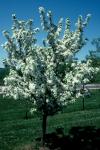Trees
are living, growing, changing organisms. Unlike fences or
brick walks, they have very specific requirements in order to
live long, healthy lives.
Too many people overlook this fact and
expect every tree to thrive forever on any site. Tree choices
are often based on what people desire rather than what the
plant needs. Improper selection leads to over 90 percent of
the tree problems reported every year. It is a case of the
wrong tree in the wrong spot.
Some trees are able to take advantage of the
limited light conditions on the fringes of forests or beneath
larger trees. Planting understory trees such as flowering
dogwood (Cornus florida), striped maple (Acer
pensylvanicum), European hornbeam (Carpinus betulus), Carolina silverbell (Halesia carolina),
serviceberry (Amelanchier
arborea)
and Pagoda dogwood (Cornus
alternifolia)
in the full sun will lead to
problems. Trees stressed by the hot summer sun may develop
cankers, attract insects and have problems with burned leaves.
Most evergreens need full sun. The key
exception is the Canadian hemlock (Tsuga
canadensis)
which will do quite well in the shade
of other trees or structures.
Full sun is required by other trees for best
growth. Junipers (Juniperus sp.), yellowwood (Cladrastis
kentukea), Kousa dogwood (Cornus
kousa), hackberry (Celtis
occidentalis),
maples (Acer sp.), oaks
(Quercus sp.)
and most large growing trees benefit from sunny
locations. Trees that do not get enough sunlight will elongate
and become "top heavy" as they reach for the sun. It seems
logical to routinely feed our plants. In most cases this is
exactly the right thing to do. However, certain trees evolved
in areas with
soils of a low fertility. Feeding white pines or
junipers can lead to excessive growth which invites insect and
disease infestations.
Other trees come from sites where leaf mulch
or other factors have led to a high level of fertility.
Yellowwood, beech
(Fagus sp.), and magnolia
(Magnolia sp.)
benefit from fertile soils.
Sugar maples make magnificent specimen
trees. Unfortunately, they have site requirements that are
difficult to meet in the home landscape. They do not tolerate
salt from nearby streets and they must have good drainage down
to at least 24 inches. As they grow, they must have plenty of
room for their root system to expand. Do not put them in a
site bordered closely by sidewalks, streets or driveways.
Not all trees are created equal.
Unfortunately, it may be many years after planting before this
becomes evident to the unsuspecting homeowner. Many trees
promoted as "fast growing" often become headaches in the
landscape. Speedy growth usually translates into brittle wood
and short life.
The following trees have inherent
characteristics which lead to problems in the landscape:

Boxelder (Acer negundo)
- A weak-wooded, weedy
tree that attracts the infamous bugs that become indoor
pests every winter and spring.

European White Birch
(Betula
pendula)
- This tree
has beautiful white bark but is a target of leaf miner and
bronze birch borer which are difficult and expensive to
control.

Russian Olive
(Elaeagnus
angustifolia)
- A victim of many
diseases which kill branches and clutter the yard.

Colorado Blue Spruce
(Picea pungens)
- Often grows
too big for the site and is disfigured by Cooley spruce
galls and
Cytospora canker.
 Poplars
(Populus
sp.)
- Fast growing and fast
dieing trees that
should only be used in temporary
plantings.
Poplars
(Populus
sp.)
- Fast growing and fast
dieing trees that
should only be used in temporary
plantings.

Willow (Salix
sp.)
- Weak-wooded trees that
fall apart in wind or ice storms.

European Mountain Ash
(Sorbus
aucuparia)
- Has nice
berries but is susceptible to many serious diseases and
insects.

Siberian Elm
(Ulmus
pumila)
- Brittle-wooded trees
that fall apart in storms and are the primary food of elm
leaf beetles, another house invading nuisance pest.

Silver Maple
(Acer saccharinum)
- These trees develop
shallow roots that are difficult to mow around and lift
sidewalks and driveways. The seeds clog eavestroughs. It has
brittle wood that falls apart in ice storms.

Sycamore (Platanus occidentalis)
- The leaves and seeds can
be messy. It is also susceptible to a disease called
anthracnose which causes defoliation in the spring.

Mulberry (Morus
alba)
- These trees produce
messy fruit and self-seed throughout the landscape.

Crabapple (Malus
sp.)-
Many varieties are
plagued by
apple scab and
fireblight. Some trees produce
large amounts of messy fruit.

Scotch Pine
(Pinus
sylvestris)
- This introduced
species are susceptible to many diseases in the landscape.
Groupings become crowded and stressed easily.

White Pine (Pinus strobus)
- This large growing
tree may not fit into the home landscape. It does not do
well near roads due to sensitivity to salt sprays.
Disease resistant varieties of crab apples
and other trees should be used. Red maple (Acer rubrum), red oak
(Quercus
rubra), sweetgum (Liquidambar
styraciflua), honeylocust (Gleditsia
triacanthos)
and other desirable trees are available.
Plant the right plant in the right site and avoid the
headaches down the line.



